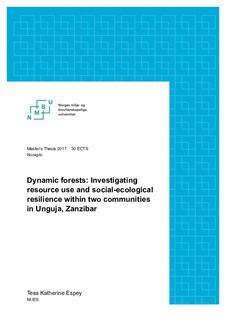| dc.description.abstract | Coral rag forests in Zanzibar are terrestrial environments with high diversity, providing multiple ecosystem services and attracting significant conservation interest. Over the past twenty years, forest management responsibilities have transitioned from the central
government to local communities, where many people engage in resource-based livelihoods.
Harvesting forest resources has been an important activity in rural areas for generations, but environmental, economic, and socio-political factors drive change and introduce disturbances in forest areas. This thesis investigates how forest harvesting and management strategies relate to social-ecological resilience in two communities. Kitogani and Muyuni A served as case studies to explore the dynamics of forested social-ecological systems on the island of Unguja. Data was collected through semi-structured interviews with multiple key stakeholder groups, including community members and leaders, government employees, NGO staff, and academics. These discussions covered a variety of related topics: resource harvesting patterns, observed changes in forest environments, important ecosystem services, and the community-based management approach. Subsequent forest surveys provided complementary information about the characteristics and condition of forest ecosystems. This process included measuring trees, classifying vegetation communities, identifying plant species, and recording patterns of disturbance and recovery encountered at sampling sites.
Data were also cross-referenced against satellite imagery and results from recent forest
inventories and research. Applying the resilience lens in this context revealed that Muyuni A and Kitogani featured complex and changing conditions as a result of multi-scale interactions, feedbacks, and variables. Coral rag forests (low to high) existed as patches on landscapes that also featured small-scale agriculture plots, shrublands, agroforests, and barrens. Vegetation in both locations exhibits high diversity and rapid growth capacity, supporting system resilience. Wood harvesting and land clearing served as the main disturbance types, however, and high harvesting rates currently hinder regeneration of woody shrubs and trees in some areas. As a result, wood and other services have declined in quality.
Socio-economic and political drivers are primary detractors from system resilience: poverty, lack of institutional support for alternative livelihood strategies, high demands for biomass energy, and limited participation in forest management are major factors. Opportunities to improve resilience within these social-ecological systems begin with fostering more participatory input, bottom-up learning and knowledge sharing, monitoring, and cross-scale connectivity within the current governance framework. | nb_NO |

